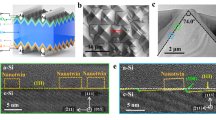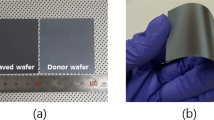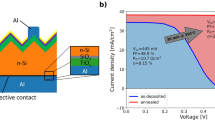Abstract
The interface of high-quality crystalline silicon/hydrogenated amorphous silicon (c-Si/a-Si:H) is indispensable for achieving the ideal conversion efficiency of Si heterojunction solar cells. Therefore, it is extremely desirable to characterize and control the interface at the atomic scale. Here, we employ spherical aberration-corrected transmission electron microscopy to investigate the atomic structure of the c-Si/a-Si:H interface in high-efficiency Si heterojunction solar cells. Their structural evolution during in situ annealing is visualized at the atomic scale. High-density embedded nanotwins, detrimental to the device performance, are identified in the thin epitaxial layer between c-Si and a-Si:H. The nucleation and formation of these nanotwins are revealed via ex situ and in situ high-resolution transmission electron microscopy. Si heterojunction solar cells with low-density nanotwins are fabricated by introducing an ultra-thin intrinsic a-Si:H buffer layer and show better performance, indicating that the strategy to restrain embedded nanotwins can further enhance the conversion efficiency of Si heterojunction solar cells.
This is a preview of subscription content, access via your institution
Access options
Access Nature and 54 other Nature Portfolio journals
Get Nature+, our best-value online-access subscription
$29.99 / 30 days
cancel any time
Subscribe to this journal
Receive 12 digital issues and online access to articles
$119.00 per year
only $9.92 per issue
Buy this article
- Purchase on Springer Link
- Instant access to full article PDF
Prices may be subject to local taxes which are calculated during checkout






Similar content being viewed by others
Data availability
All data generated or analysed during this study are included in the published article and its Supplementary Information. Source data are provided with this paper.
References
Battaglia, C., Cuevas, A. & de Wolf, S. High-efficiency crystalline silicon solar cells: status and perspectives. Energy Enviro. Sci. 9, 1552–1576 (2016).
Haschke, J., Dupré, O., Boccard, M. & Ballif, C. Silicon heterojunction solar cells: recent technological development and practical aspects – from lab to industry. Sol. Energy Mater. Sol. Cells 187, 140–153 (2018).
Trube, J. International Technology Roadmap for Photovoltaic (ITRPV): Eleventh Edition Online (2020); https://itrpv.vdma.org/viewer/-/v2article/render/48393879
Richter, A., Hermle, M. & Glunz, S. W. Reassessment of the limiting efficiency for crystalline silicon solar cells. IEEE J. Photovolt. 3, 1184–1191 (2013).
Yoshikawa, K. et al. Silicon heterojunction solar cell with interdigitated back contacts for a photoconversion efficiency over 26%. Nat. Energy 2, 17032 (2017).
Fuhs, W., Niemann, K. & Stuke, J. Heterojunctions of amorphous silicon and silicon single crystals. AIP Conf. Proc. 20, 345–350 (1974).
De Wolf, S., Descoeudres, A., Holman, Z. C. & Ballif, C. High-efficiency silicon heterojunction solar cells: a review. Green 2, 7–24 (2012).
Adachi, D., Hernández, J. L. & Yamamoto, K. Impact of carrier recombination on fill factor for large area heterojunction crystalline silicon solar cell with 25.1% efficiency. Appl. Phys. Lett. 107, 233506 (2015).
Green, M. A. et al. Solar cell efficiency tables (version 51). Prog. Photovoltaics Res. Appl. 26, 3–12 (2018).
Yamamoto, K., Yoshikawa, K., Uzu, H. & Adachi, D. High-efficiency heterojunction crystalline Si solar cells. Jpn J. Appl. Phys. 57, 08RB20 (2018).
Essig, S. et al. Raising the one-sun conversion efficiency of III–V/Si solar cells to 32.8% for two junctions and 35.9% for three junctions. Nat. Energy 2, 17144 (2017).
Bush, K. A. et al. 23.6%-efficient monolithic perovskite/silicon tandem solar cells with improved stability. Nat. Energy 2, 17009 (2017).
Hekmatshoar, B., Shahrjerdi, D., Hopstaken, M., Ott, J. A. & Sadana, D. K. Characterization of thin epitaxial emitters for high-efficiency silicon heterojunction solar cells. Appl. Phys. Lett. 101, 103906 (2012).
de Wolf, S., Ballif, C. & Kondo, M. Kinetics of a-Si:H bulk defect and a-Si:H/c-Si interface-state reduction. Phys. Rev. B 85, 113302–113306 (2012).
Park, J. S., Kim, S., Xie, Z. & Walsh, A. Point defect engineering in thin-film solar cells. Nat. Rev. Mater. 3, 194–210 (2018).
Li, H. et al. The amorphous/crystalline silicon interface research of HIT solar cells by simulation. Adv. Mater. Res. 773, 124–131 (2013).
Pankove, J. I. & Tarng, M. L. Amorphous silicon as a passivant for crystalline silicon. Appl. Phys. Lett. 34, 156 (1979).
Fujiwara, H. & Kondo, M. Impact of epitaxial growth at the heterointerface of a-Si:H/c-Si solar cells. Appl. Phys. Lett. 90, 013503 (2007).
Descoeudres, A. et al. Improved amorphous/crystalline silicon interface passivation by hydrogen plasma treatment. Appl. Phys. Lett. 99, 123506 (2011).
Yan, Y. et al. Atomic structure and electronic properties of c-Si/a-Si:H heterointerfaces. Appl. Phys. Lett. 88, 121925 (2006).
Geissbühler, J. et al. Amorphous/crystalline silicon interface defects induced by hydrogen plasma treatments. Appl. Phys. Lett. 102, 231604 (2013).
Ali, H. et al. Thermal stability of hole-selective tungsten oxide: in situ transmission electron microscopy study. Sci. Rep. 8, 12651 (2018).
Ali, H. et al. In situ transmission electron microscopy study of molybdenum oxide contacts for silicon solar cells. Phys. Stat. Sol. A 216, 1800998 (2019).
Fan, Z. et al. In situ transmission electron microscopy for energy materials and devices. Adv. Mater. 31, 1900608 (2019).
Urban, K. W. Studying atomic structures by aberration-corrected transmission electron microscopy. Science 321, 506–510 (2008).
Sun, J. et al. Liquid-like pseudoelasticity of sub-10-nm crystalline silver particles. Nat. Mater. 13, 1007–1012 (2014).
Divitini, G. et al. In situ observation of heat-induced degradation of perovskite solar cells. Nat. Energy 1, 15012 (2016).
Zou, L., Li, J., Zakharov, D., Stach, E. A. & Zhou, G. In situ atomic-scale imaging of the metal/oxide interfacial transformation. Nat. Commun. 8, 307 (2017).
Gong, Y. et al. Three-dimensional atomic-scale observation of structural evolution of cathode material in a working all-solid-state battery. Nat. Commun. 9, 3341 (2018).
Zhao, H. et al. Atomic-scale understanding of stress-induced phase transformation in cold-rolled Hf. Acta Mater. 131, 271–279 (2017).
Hao, M. et al. Ligand-assisted cation-exchange engineering for high-efficiency colloidal Cs1−xFAxPbI3 quantum dot solar cells with reduced phase segregation. Nat. Energy 5, 79–88 (2020).
Wang, T. H. et al. Effect of emitter deposition temperature on surface passivation in hot-wire chemical vapor deposited silicon heterojunction solar cells. Thin Solid Films 501, 284–287 (2006).
Zhu, Y. et al. Unravelling surface and interfacial structures of a metal-organic framework by transmission electron microscopy. Nat. Mater. 16, 532–536 (2017).
Sakaguchi, N., Ichinose, H. & Watanabe, S. Atomic structure of faceted Σ3 CSL grain boundary in silicon HRTEM and ab-initio calculation. Mater. Trans. 48, 2585–2589 (2007).
Neaton, J. B., Muller, D. A. & Ashcroft, N. W. Electronic properties of the Si/SiO2 interface from first principles. Phys. Rev. Lett. 85, 1298–1301 (2000).
Ramos, L. E. et al. Structural, electronic, and effective-mass properties of silicon and zinc-blende group-III nitride semiconductor compounds. Phys. Rev. B 63, 165210 (2001).
Deák, P., Aradi, B., Frauenheim, T., Janzén, E. & Gali, A. Accurate defect levels obtained from the HSE06 range-separated hybrid functional. Phys. Rev. B 81, 153203 (2010).
Huebl, H. et al. Phosphorus donors in highly strained silicon. Phys. Rev. Lett. 97, 166402 (2006).
Yin, W. J., Shi, T. & Yan, Y. Unique properties of halide perovskites as possible origins of the superior solar cell performance. Adv. Mater. 26, 4653–4658 (2014).
Vogt, P. et al. Silicene: compelling experimental evidence for graphenelike two-dimensional silicon. Phys. Rev. Lett. 108, 155501 (2012).
Zhang, L. et al. Effect of copassivation of Cl and Cu on CdTe grain boundaries. Phys. Rev. Lett. 101, 155501 (2008).
Abou-Ras, D. et al. Confined and chemically flexible grain boundaries in polycrystalline compound semiconductors. Adv. Energy Mater. 2, 992–998 (2012).
Meinel, K., Klaua, M. & Bethge, H. On twin and stacking fault formation during the epitaxial film growth of F.C.C. materials on (111) substrates. Phys. Stat. Sol. 110, 189–196 (1988).
Zhai, S. et al. The twin formations on different growth planes of silicon crystal growth from melt by a molecular dynamics study. Phys. B 572, 184–189 (2019).
Kresse, G. & Hafner, J. Ab initio molecular dynamics for liquid metals. Phys. Rev. B 47, 558–561 (1993).
Perdew, J. P., Burke, K. & Ernzerhof, M. Generalized gradient approximation made simple. Phys. Rev. Lett. 77, 3865–3868 (1996).
Momma, K. & Izumi, F. VESTA: a three-dimensional visualization system for electronic and structural analysis. J. Appl. Crystallogr. 41, 653–658 (2008).
Kimmerle, A., Rothhardt, P., Wolf, A. & Sinton, R. A. Increased reliability for J0-analysis by QSSPC. Energy Procedia 55, 101–106 (2014).
Mäckel, H. & Varner, K. On the determination of the emitter saturation current density from lifetime measurements of silicon devices. Prog. Photovoltaics Res. Appl. 21, 850–866 (2012).
Janssen, G. J. M., Wu, Y., Tool, K. C. J. J., Romijn, I. G. & Fell, A. Extraction of recombination properties from lifetime data. Energy Procedia 92, 88–95 (2016).
Augusto, A., Herasimenka, S. Y., King, R. R., Bowden, S. G. & Honsberg, C. Analysis of the recombination mechanisms of a silicon solar cell with low bandgap-voltage offset. J. Appl. Phys. 121, 205704 (2017).
Acknowledgements
This work was financially supported by the National Natural Science Foundation of China (no. 11774016, 61922005, 11874314 and 62034001), Beijing Great Wall Scholars Program, Beijing Academic Outstanding Young Scientists Projects (BJJWZYJH01201910005018) and Australian Research Council. We thank Y. Zhang, M. Yang and C. Yu for device fabrication and SHJ cell process development, X. Chen for theoretical calculations and Y. Qin for SEM characterization from Carl Zeiss.
Author information
Authors and Affiliations
Contributions
X.Q. prepared the TEM sample and executed aberration-corrected HRTEM and HAADF-STEM. Y.H., M.Q. and T.R. fabricated the devices and carried out photovoltaic characterization. F.C. and Z.Z. carried out theoretical calculations. Y.M and Y.C. assisted with the theoretical calculations. X.R. assisted in the fabrication of devices. X.Q., Y.Z. and K.Z. analysed the experimental results and wrote the manuscript. X.X., H.Y. and Lihua Wang made helpful comments on the manuscript. X.H., Z.H., Z.-G.C. and Lianzhou Wang guided the PCE loss analysis and provided constructive suggestions. K.Z. and Y.Z. led the entire project. All authors read the manuscript and contributed to the discussion of the results.
Corresponding authors
Ethics declarations
Competing interests
The authors declare no competing interests.
Additional information
Peer review information Nature Energy thanks Urs Aeberhard, Kristopher Davis and the other, anonymous, reviewer(s) for their contribution to the peer review of this work.
Publisher’s note Springer Nature remains neutral with regard to jurisdictional claims in published maps and institutional affiliations.
Supplementary information
Supplementary Information
Supplementary Figs. 1–13, Table 1 and references.
Source data
Source Data Fig. 1
An efficiency of 24.85% is certified by the Institute for Solar Energy Research in Hamelin with a total area of 244.5 cm2 measured under standard test conditions.
Source Data Fig. 5
Source data of Fig. 5d.
Rights and permissions
About this article
Cite this article
Qu, X., He, Y., Qu, M. et al. Identification of embedded nanotwins at c-Si/a-Si:H interface limiting the performance of high-efficiency silicon heterojunction solar cells. Nat Energy 6, 194–202 (2021). https://doi.org/10.1038/s41560-020-00768-4
Received:
Accepted:
Published:
Issue Date:
DOI: https://doi.org/10.1038/s41560-020-00768-4
This article is cited by
-
Flexible silicon solar cells with high power-to-weight ratios
Nature (2024)
-
Prediction of sub-pyramid texturing as the next step towards high efficiency silicon heterojunction solar cells
Nature Communications (2023)
-
Ultra-thin Ag/Si heterojunction hot-carrier photovoltaic conversion Schottky devices for harvesting solar energy at wavelength above 1.1 µm
Scientific Reports (2023)
-
Silicon heterojunction solar cells with up to 26.81% efficiency achieved by electrically optimized nanocrystalline-silicon hole contact layers
Nature Energy (2023)
-
Industrial-scale deposition of nanocrystalline silicon oxide for 26.4%-efficient silicon heterojunction solar cells with copper electrodes
Nature Energy (2023)



